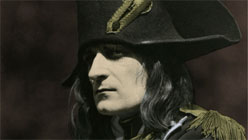In the decadent Paramount Theatre, attending Napoleon feels like an act of history. The audience is finely dressed in vests and hats and some use umbrellas as canes — one audience member even dons a stylish bicorne hat, which she pairs with a double-breasted coat and heels. Buzzing, attendees saunter in early to hear the orchestra tune in that cacophony that precedes the grand opening of the curtain. The titles win applause, and though clapping for a film can often feel arbitrary, here at the Paramount — it is inspired.
Napoleon, the 1927 film by French silent film master Abel Gance, has never been shown in its entirety. Reconstructed by Gance scholar Kevin Brownlow and presented by the San Francisco Silent Film Festival, this five and a half hour version will likely be the closest we will ever get to see the film as the director intended. The Oakland East Bay Symphony provides a marvelous accompaniment under the direction of Carl Davis, who wrote the score for a series of screenings in 1981. The synched three-projection finale of Napoleon is exceedingly rare. When Gance innovated this technique (later called Polyvision), he believed it to be the future of cinema. His experiential approach, placing the audience within the grandiose landscape of Napoleon’s Italian campaign, makes this production a true live event.
The film opens on a Champagne hillside at Napoleon’s military school. Headmasters huddle around snowy windows and overlook a grave snowball fight. The warring boys are well-entrenched in forts, dressed in full Revolutionary uniforms. Ten versus forty reads the title card. Napoleon, played ruthlessly by the young Vladimir Roudenko, displays iconic fortitude. Amidst an onslaught of snow, he is unmoved while directing his nine child-soldiers. He uses a mirrored belt buckle to survey the battlefield. The camera follows along with the pounding of a timpani drum. These boyhood squabbles are not a metaphor — aside from being historical, they are also Gance’s first battle scene.
 Vladimir Roudenko as the young Napoleon. Photo courtesy Photoplay Productions.
Vladimir Roudenko as the young Napoleon. Photo courtesy Photoplay Productions.As boy or man, Napoleon is never seen outside of military uniform. He wears tight white trousers, leather boots, and a dark jacket that flares out in a ‘V’. His hat rarely leaves his head, giving his silhouette the shape of an erect hammerhead shark. He is centered and aloof through the French Revolution, the Reign of Terror, and imprisonment for espionage. Every character in this film is set to counter Napoleon. In a brilliant performance of Napoleon, Albert Dieudonné meets their ignorance, indifference, and malice with proud obstinacy. While aristocrats are dragged to the guillotine, he remains bent over a map, planning his empire.

 Three projections complete the finale. Photo courtesy Photoplay Productions.
Three projections complete the finale. Photo courtesy Photoplay Productions.
